 |
||
|
||
| ||
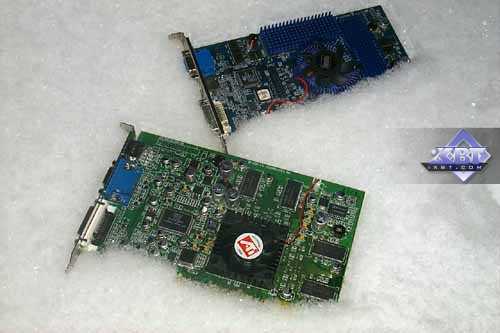 Almost a year ago we published a similar article when we overclocked video cards in extreme conditions. Today we continue our experiments. Remember that video cards do not stop being valid for after-sales service as no soldering of components that changes voltage on memory or on a chip was carried out. To reach the highest results in overclocking we put a system block with the tested video card into the conditions of quite low temperatures (but not too low to damage equipment with movable parts). Both ways of extreme overclocking are not for an ordinary user as rise of voltage on a chipset and/or memory makes a video card age quickly, while exploitation in low temperatures is almost impossible at home. That is why we conduct these experiments just to find out what performance can be achieved if GPU developers made a transition to a new technological process providing thus higher frequencies for the same chips (something like GeForce2 GTS - GeForce2 Ultra). The experiments were carried out on the most powerful accelerators based on processors from ATI and NVIDIA; they were tested outdoors at -11 degrees Celsius. Today we have two cards to test: ATI RADEON 8500 (275/550 MHz) and Hercules 3D Prophet III Titatium 500 on the NVIDIA GeForce3 Ti 500. Both cards were examined earlier at our site. Test system configuration:
Installation and driversIn the tests we used NVIDIA drivers of v.21.85 and ATI ones of v. 7.206 (we didn't use the latest drivers of v.9.* as the tests were carried out with the Return to Castle Wolfenstein game and here the performance of the RADEON 8500 is much higher). Besides, VSync was off and S3TC was activated. 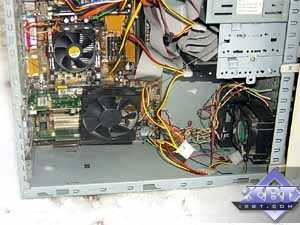 After the tests the processor's temperature was +1 degrees Celsius and the mainboard was of -6 degrees Celsius. Test resultsTest program:
Return to Castle Wolfenstein (Multiplayer)ixbtdemo, highest quality modesThe test was carried out in a 32-bit color mode at the highest possible detailing level and texture quality. Frequencies of the core and memory on both cards were gradually increased, and the cards were tested three times in 1024x768, 1280x1024 and 1600x1200. ATI RADEON 8500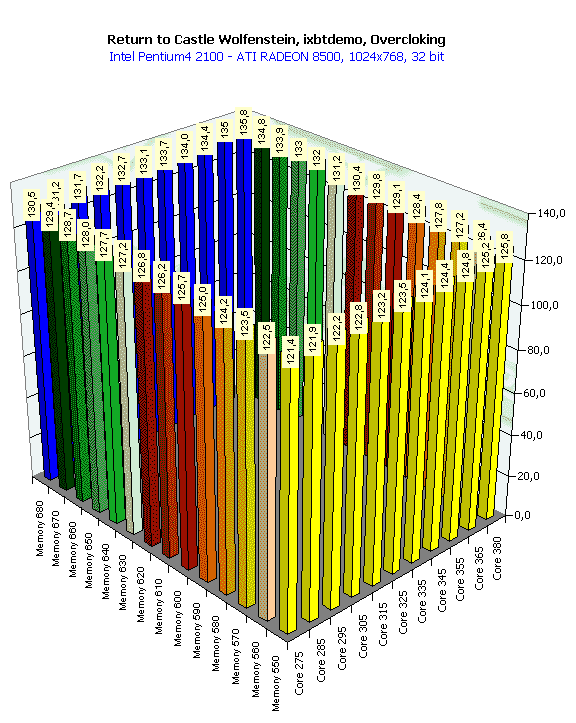 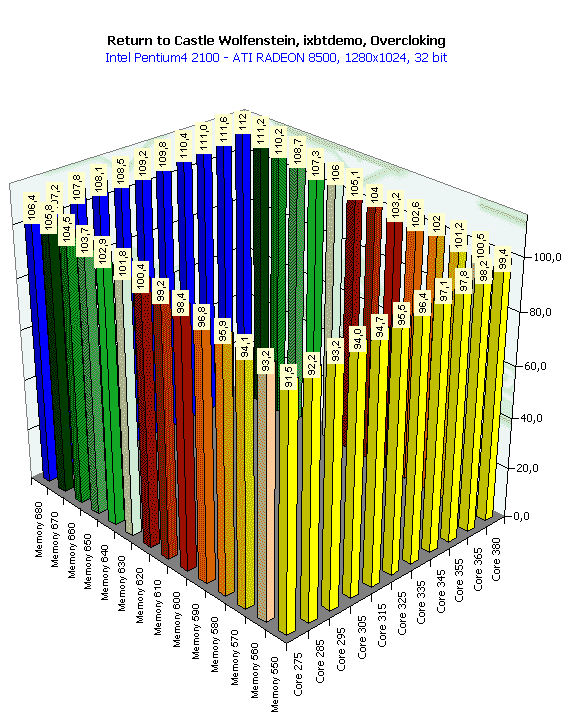  Well, the performance boost is not great, though we should account for the complexity of this test (it is not the Quake3 where a performance surpasses 170-200 fps). Let's take a look at the NVIDIA GeForce3 Ti 500. NVIDIA GeForce3 Ti 500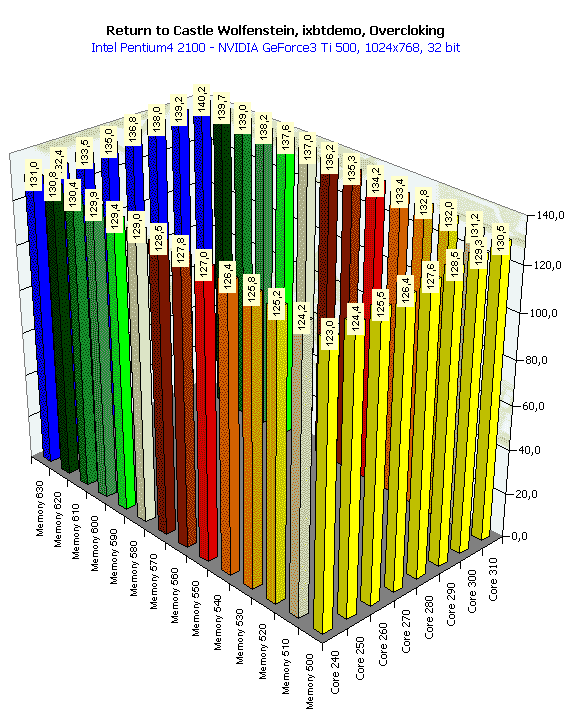 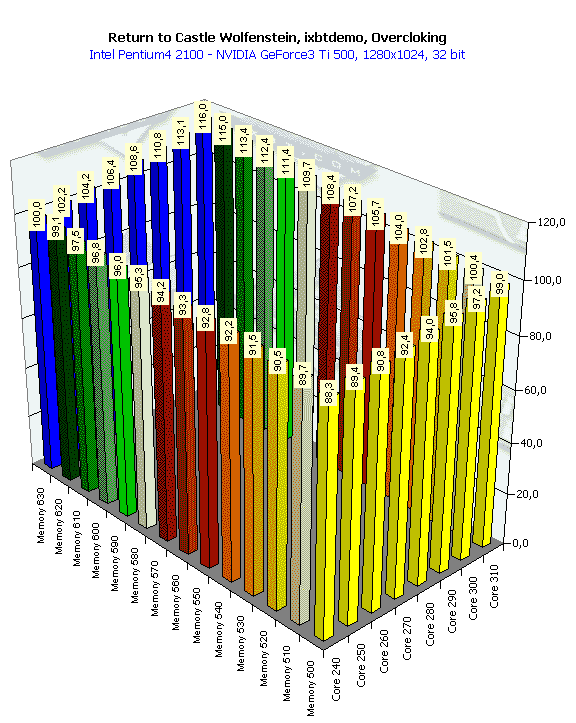  In general, it performs very close to the other card but remember that the highest frequencies this card has reached are much lower than those of the RADEON 8500. The table below can help us analyze the data:
The GeForce3 Ti 500 has a higher performance growth percentage-wise per a unit of frequency increase as compared with the RADEON 8500. For example, in 1600x1200 the speed grows by more than 1% for 1% of the frequency growth, while speedup of the RADEON 8500 is less than 1%. It is interesting that the performance of the Ti 500 becomes more dependent on the memory speed as the resolution grows; it means that the chip is still powerful enough while the memory bandwidth is limiting the card. In case of the RADEON 8500 the situation is different: in 1600x1200 the performance growth becomes less as the memory frequency increases (relative to the previous resolutions); it means that at 340 (680) MHz of the memory the power of the chip is not enough any more while the memory doesn't slow down the overall performance. ixbtdemo, highest quality modes, anisotropic filtering and anti-aliasing enabledThe tests were carried out in the 32-bit color mode at the highest possible detailing level and texture quality. For the GeForce3 Ti 500 we activated anisotropic filtering of Level4 and anti-aliasing of the Quincunx level, and for the RADEON 8500 we enabled anisotropic filtering of the 16x degree and anti-aliasing of 2x Quality. ATI RADEON 8500 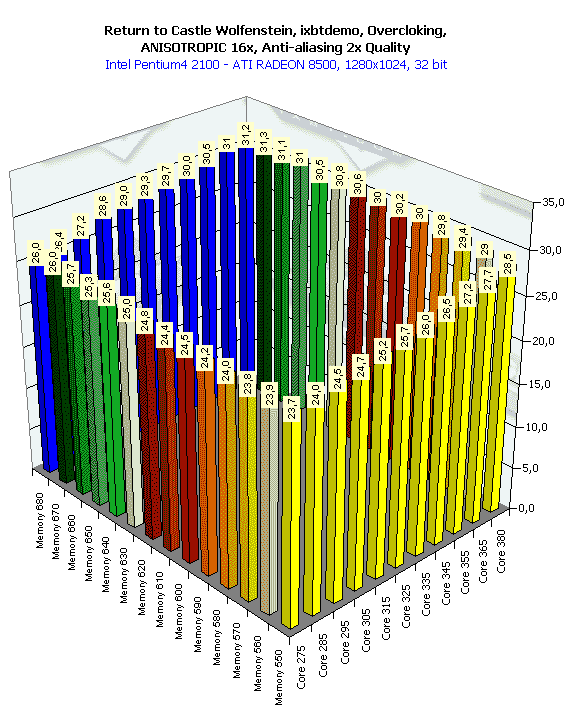 As before, the performance doesn't grow much although the frequencies go up swiftly. NVIDIA GeForce3 Ti 500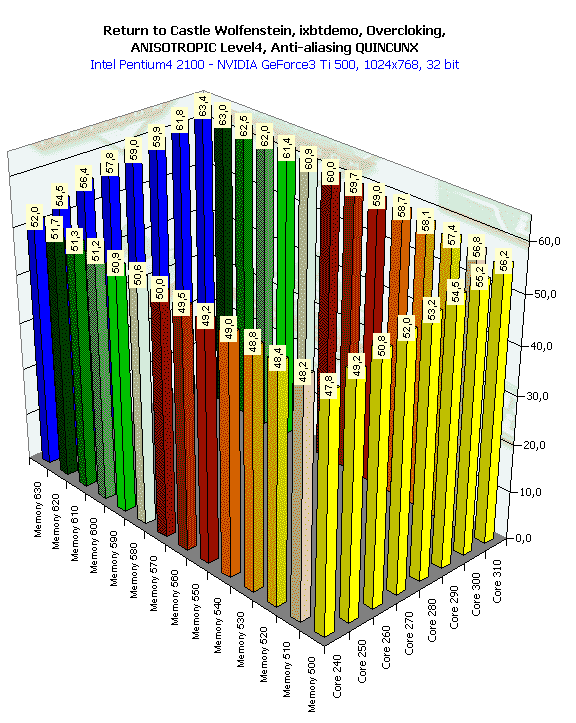  The Ti 500 performs better than the RADEON 8500 (if I'm allowed to compare different anisotropy filterings and different ways of realization of the anti-aliasing). The card has greater performance growth for a unit of the frequency increase. ConclusionThe RADEON 8500 which possesses a well-organized architecture works at its breaking point, and its capabilities depend not only on core and memory frequencies. On the contrary, the GeForce3 Ti 500 demonstrates a pure dependence on the frequency, and I can assume that if both processors were able to run at 300 Mhz the RADEON 8500 would fall behind by a great margin. It has a less 3D processing speed gain per a unit of the frequency growth than the GeForce3 Ti 500. But it is possible that such a reaction of the RADEON 8500 to overclocking is caused by the definite platform (i850, Pentium4), i.e. maybe the drivers do not entirely optimized for this platform. The third conclusion concerns the game. If we load the cards with the anisotropic filtering and anti-aliasing (the Return to Castle Wolfenstein is also meant for a single user) the GeForce3 Ti 500 will have higher playability at the increased frequencies with the resolution going up though the frequency growth is not so high as in case of the RADEON 8500. In our 3Digest
you can find complete comparison characteristics of video cards
of this and other classes.
Write a comment below. No registration needed!
|
Platform · Video · Multimedia · Mobile · Other || About us & Privacy policy · Twitter · Facebook Copyright © Byrds Research & Publishing, Ltd., 1997–2011. All rights reserved. | |||||||||||||||||||||||||||||||||||||||||||||||||||||||||||||||||||||||||||||||||||||||||||||||||||||||||||||